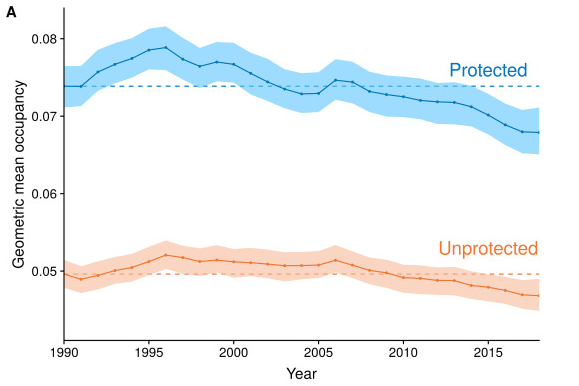Scientific papers using recording scheme data
Protected areas support more species than unprotected areas in Great Britain, but lose them equally rapidly (Cooke et al. 2022)
A new study, led by researchers from the UK Centre for Ecology & Hydrology (UKCEH) as shown that protected natural areas of the UK are struggling to halt declines in insects and spiders that have occurred over the past 30 years.
This work is based on nearly one million records for more than 1,230 invertebrate species between 1990 and 2018, collected by the following UK recording schemes:
Protected areas such as Nature reserves, Sites of Special Scientific Interest (SSSIs), Special Areas of Conservation and other forms of protected habitat, have long been regarded as a key tool in conservation efforts to preserve and restore natural habitats.
The authors found that protected areas were richer in species than unprotected areas of the country, but that both areas have suffered similar rates of decline in native insects and spiders over the past 30 years. They suggest that protected ares are just as susceptible to the wider declines in biodiversity occurring across the country, and that pollinators, such as bees and hoverflies, have suffered particularly severe declines.
The paper, ‘Protected areas support more species than unprotected areas in Great Britain, but lose them equally rapidly’ is published in Biological Conservation, and you can read more abut this on the UKCEH website here.
Diversity, fragmentation, and connectivity across the UK amphibian and reptile data management landscape (Turner et al. 2022)
Assesses the scope of available data on amphibians and reptiles in the UK, highlighting a largely uneven taxonomic, geographic and temporal coverage of datasets with no single source currently suitable for producing robust multispecies assessments on large scales. The authors call for improved metadata to accompany biological records datasets, and recommend integration and greater stakeholder collaboration behind a coordinated infrastructure for data collection, storage and analysis.
An evidence-base for developing ambitious yet realistic national biodiversity targets (Bane et al. 2022)
This study presents evidence from recent population trends of 670 terrestrial animal species (for which abundance time series are available) as a species abundance indicator, together with a synthesis of case studies on species recovery, to assess the degree to which legally-binding government targets to halt biodiversity decline, are achievable.
Integrating expert knowledge at regional and national scales improves impact assessments of non-native species (Dehnen-Schmutz et al. 2022)
The Botanical Society of Britain and Ireland (BSBI) vice-county recorders have an unrivalled knowledge of the plant species, both native and non-native, that occur at a local level, including their distribution, abundance, habitats and regeneration, while also being aware of impacts on other plant species and ecosystem processes. This study gathered their insight into which speices had highest environmental impacts at the vice-county level, and found they both confirmed results from national assessments, but also identified less well documented, but widely distributed species, as well as species with limited occurrences and high impacts locally.
Abundance trends for river macroinvertebrates vary across taxa, trophic group and river typology (Powell et al 2023)
Data on riverine macroinvertebarte abundance in England over 18 years, from the Environment Agency's ecological monitoring database, were analysed. The study revealed a complex picture of change in freshwater macroinvertebrate abundance between taxonomic groups, trophic levels and river typologies, helping to identify priority regions for action on potential environmental stressors.
Statistical methods papers
Simple methods for improving the communication of uncertainty in temporal trends (Pescott et al. 2022)
A call for full transparency in the scientific process by clearly displaying the multiple sources of uncertainty that can be estimated by researchers, presenting a simple and widely applicable approach for clear communication of model-based uncertainty. The techniques are demonstrated here using the example of long-term plant distributional change in Britain, and can also be seen applied to the trends of thousands more plant species in the UK in the recently published Plant Atlas 2020.
We need to talk about nonprobability samples (Boyd et al. 2023)
In most circumstances, probability sampling is the only way to ensure unbiased inference about population quantities where a complete census is not possible. As we enter the era of ‘big data’, however, nonprobability samples, whose sampling mechanisms are unknown, are undergoing a renaissance. This paper explains why the use of nonprobability samples can lead to spurious conclusions, and why seemingly large nonprobability samples can be (effectively) very small. The authors also review some recent controversies surrounding the use of nonprobability samples in biodiversity monitoring. These points notwithstanding, the authors argue that nonprobability samples can be useful, provided that their limitations are assessed, mitigated where possible and clearly communicated. suggesting that ecologists can learn much from other disciplines on each of these fronts.
